Biography - John W. Duarte
John William Duarte was born on 2 October 1919 in Sheffield, England. His widowed mother had had an affair with a commissioned officer in the London Scottish Regiment, who subsequently died in 1919 and Duarte kept his mother's married name. When he was six months old they moved to Manchester where they shared a house with her parents. He was educated at Manchester Central High School and, later, the Manchester College of Technology (now UMIST), from where he graduated with a B.Sc. (Hons) in 1940, specialising in textile chemistry.
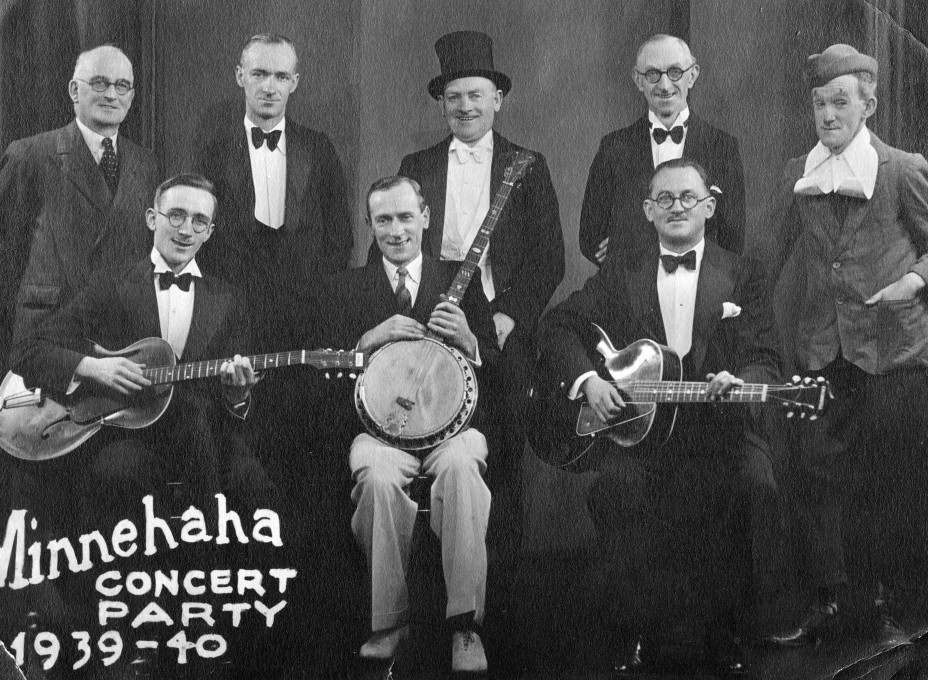
Duarte's first musical instruments were the piano and the ukulele and it wasn't until 1934 that a cousin bought him a guitar. Ida Presti was one of the famous guitarists to play this instrument, nicknamed 'Little Nell'. It was also at this point that he received jazz (plectrum) guitar lessons, with Terence Usher, in a series of 10 lessons spread over 18 months, starting in January 1935, where Usher taught him not only the guitar, but notation and general musicianship. In later life Duarte would call him, 'a remarkable teacher'. Chemistry and music developed in parallel and Duarte's lifelong interest in jazz began at this point. The transition to higher education meant more contact with different instrumentalists and he soon joined various dance bands and small groups, including the Minnehaha Concert Party.
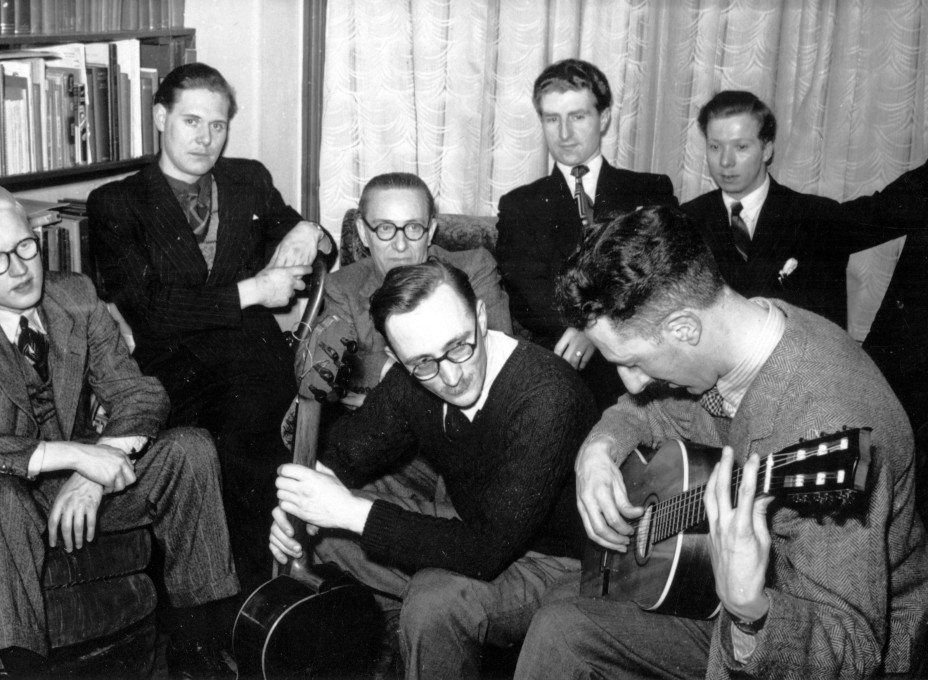
A meeting of the Manchester Guitar Circle 1950. Terry Usher playing, Duarte looking on.
As the need arose Duarte also learned to play the trumpet and double bass. The world of the plectrum guitar was populated by some heroes such as Eddie Lang, Lonnie Johnson, Teddy Bunn and, bursting on to the scene like a bombshell in the mid-1930s, the French guitarist, Django Reinhardt and his Hot Club de France Quintet. In the late 30s, as a double bassist, Duarte played in a five-hour long session with Django and Joseph Reinhardt and the singer, Adelaide Hall and in a concert with Coleman Hawkins. Duarte was also exploring classical music and its place on the guitar. In conjunction with Usher, they made more than 200 arrangements for guitar duet, anything from piano music to symphonies.
During World War II Duarte was Chief Chemist in a Ministry of Supply Factory, producing guncotton, material for uniforms and tyres and it was here that he met Dorothy Seddon, who became his wife in 1943. The war years were a time of discovery for Duarte, listening to the latest jazz soloists and groups on the radio and in concerts as well as beginning his lifelong correspondence battles in the press.
Usher and Duarte founded the Manchester Guitar Circle in 1946 and Julian Bream was a guest artist in 1947. A seminal moment arrived in February 1948 when a group from the club drove across the Pennines to hear Segovia play a concert in Leeds. After the concert, Usher showed Segovia some of Duarte's compositions, including his Sonata Op.4. Segovia expressed an interest in the music and there began a near 40-year friendship. Duarte's interests and influences continued to grow and in 1952 he was invited by Len Williams, father of John Williams, to take on the young prodigy. John's technical abilities were never in doubt, but it was with his musicianship and aural skills that help was needed, before Williams entered the Royal College of Music, London. The Duarte family moved to London in 1953 and in addition to his job as Chief Chemist of Arlington Plastics Development Ltd, Duarte took on a teaching position at Len Williams' Spanish Guitar Centre.
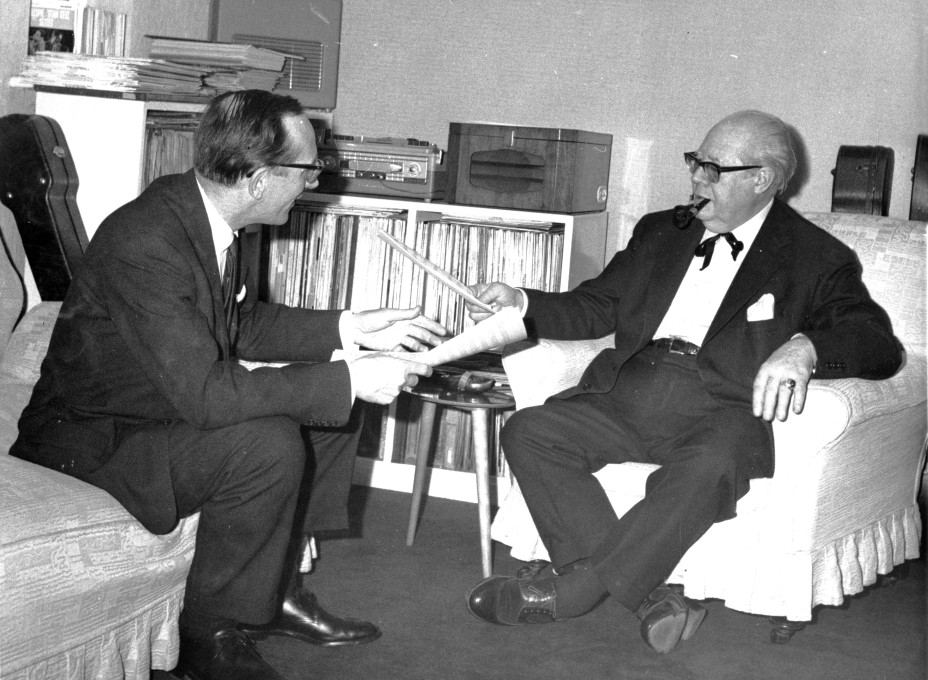
Duarte and Andrés Segovia at Duarte's home, Morton Way, London, 1965.
The 1950s sparked Duarte's compositional career. New works for flute/guitar, voice/guitar and string trio/guitar were added to pieces for guitar solo. John Williams premiered several of these works and, with Segovia's help, Duarte began an association with the 'Guitar Review' journal, in New York. Initially, he reported on concerts and other events, but this soon blossomed into writing more technical articles and providing new music for their supplements. Duarte already had several pieces published with Schott & Co. and the performance of his Variations on a Catalan Folk Song Op.25, premiered by John Williams, opened more doors for him. The premiere by Segovia of English Suite Op.31, in 1966, proved to be a major turning point.
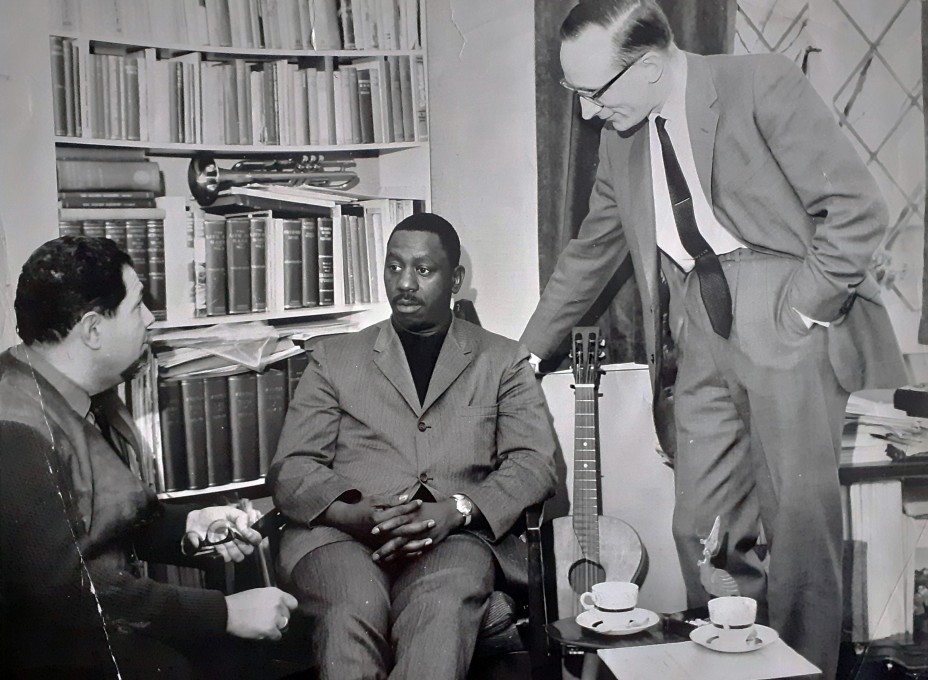
Ike Isaacs, Wes Montgomery and Duarte at Duarte's home, Morton Way, London, 1965. Duarte's first guitar, "Little Nell", is under Duarte's arm.
During the 1960s Duarte continued his interest in jazz guitar, corresponding with Tal Farlow, Jim Hall and Wes Montgomery. In parallel he forged new friendships with classic guitar players, including, among others, the Presti/Lagoya Duo, Evangelos and Liza, the Abreu brothers, Alice Artzt, Ernesto Bitetti, Alirio Diaz, Angelo Gilardino and Pieter van der Staak. Another offshoot at this time was his educational music - studies, a tutor, several books of easy arrangements for guitar solo, recorder/guitar and voice/guitar. This aspect of his work was very important to him, partly because of the presence of young children in the house and also his wife, who played the recorder. Duarte's ground-breaking transcriptions of two Bach cello suites - recorded by Williams and Segovia, among others - led to his increased interest in Renaissance music, resulting in many transcriptions of lute, cittern and bandora music. His work particularly concentrated on the works of the father and son Dowland.
Duarte was working for a small research company from 1966, but in 1969 was made redundant. He and Dorothy decided it would be a good idea if he tried to make music his full-time occupation and the Duartes moved from Arnos Grove to Highgate, London, having bought a newspaper/tobacconist shop. This brought in regular income and enabled Duarte to spend more time on composing, arranging, writing articles and making further connections with the guitar community in Europe and the USA. By 1973 the shop was sold and music became Duarte's full-time career. In these four years 20 original pieces were composed, as well as many arrangements and collections. In the previous 10 years, only 14 original works were produced, as well as arrangements and collections.
In the early 1970s a by-product of Duarte's new connections was teaching invitations to guitar summer schools in Sweden, Holland and Italy and masterclasses in Australia and the USA, as well as being a jury member for competitions, all of which he was still doing 30 years later. In total, he visited 29 countries, many of them many times, as a teacher, adjudicator or lecturer. At this point he was also taking on private students, a large proportion of them from abroad. Lessons were often lengthy affairs of at least two hours and included much listening to other instrumentalists. Articles about guitar technique and harmony continued to flow from his typewriter - his handwriting was really appalling! - including several series, especially on music theory and harmony, in 'BMG' (Banjo Mandolin Guitar) magazine and, in the 1980s, 'Guitar Player' magazine. He also started to review recordings in 'Records and Recording' magazine, printed music for periodicals such as 'The Musical Time's and concerts for 'Music and Musicians'. A long-running feature of Duarte's writing was his wrangles with readers of magazines. Disagreements about players, teaching styles, (a) or (b)'s knowledge about (x) and a whole host of other matters kept readers amused, annoyed and, when they had finished, relieved, for many years. His lengthy disagreements with the editor of 'Guitar' magazine were finally resolved when Duarte was appointed Reviews Editor of the magazine! He was an almost fanatical letter-writer, exchanging, sometimes, 100s of letters with other guitarists and other musicians. The morning post was often followed by two hours of typing and a resultant pile of letters for posting.
As the 1970s progressed Duarte was more and more in demand as a composer. He began to experiment with different compositional styles and systems, incorporating 12-note (tone), aleatoric, pan-diatonic, jazz and graphic elements into his scores. Some performers buckled under the challenge, but others thrived on it. A steady stream of original music flowed from his pen, sometimes up to six or seven works a year. In combination with the educational music and arrangements/transcriptions this was a significant increase in workload. The reviewing, writing and teaching continued as did his tally of overseas trips, with the USA being a regular destination. 1974 heralded the beginning of his time as Director of the Cannington Guitar Summer School in Somerset, England, which lasted until 1993. Cannington became a focal point of his life and also the largest summer school of its type in Europe, with nearly 100 students in some years. Dorothy played a vital role here, looking after the finances (especially after it became independent of the early sponsor, Universal Edition) and the welfare of the students. Many arrangements and works for student ensembles began to be written and this continued through the various other summer schools which followed, at Bath, England (1994-95) and Oatridge, Scotland (1996-1999). After the early 1970s editions of Robert Dowland's A Varietie of Lute-Lessons, in association with the lute expert, Diana Poulton, Duarte embarked on a series of transcriptions for one or two guitars, of Scarlatti keyboard sonatas.
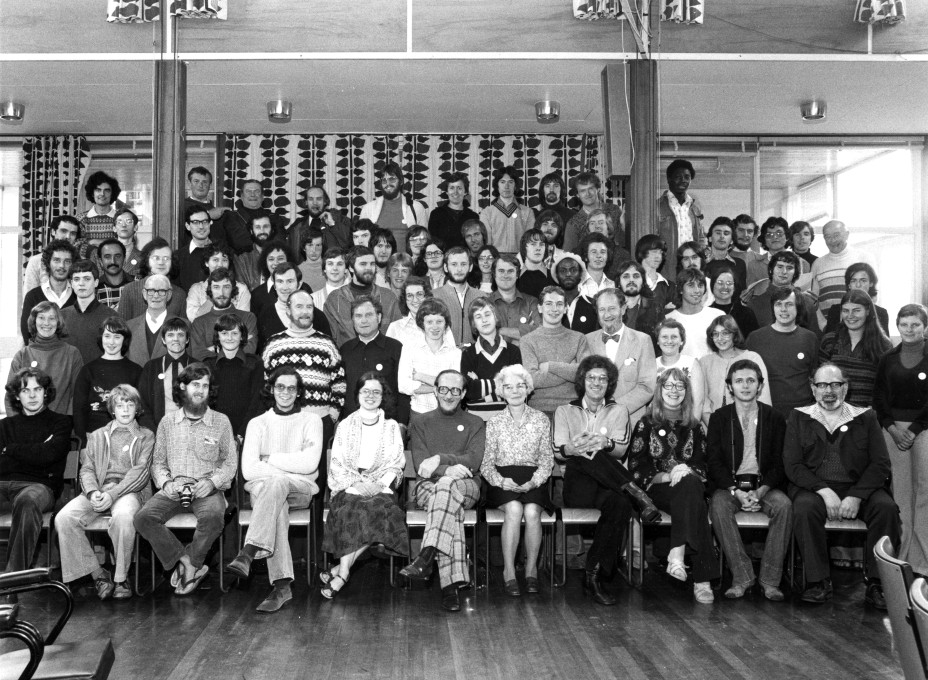
Cannington Summer School, Cannington, Somerset, England, August 1977.
In 1980 Duarte received a GRAMMY award for his liner notes to the reissue of Segovia's 1927-1939 EMI recordings. His writing in this genre extended to more than 250 liner notes and he developed particular specialisms in Vivaldi and all sorts of Spanish music. His notes ranged from the obvious guitar music, to Elgar concerti, Mexican orchestral music, Schubert string quartets and a complete survey of Vivaldi's bassoon concerti. Overseas visits continued and during this decade he made more than 30 trips, including to Canada, New Zealand, Mexico, USA, Greece, Germany, Spain and Scandinavia. By this time he had also moved from Records and Recording magazine to the much more prestigious 'Gramophone'. His purview here extended to Baroque and Renaissance music recordings of all kinds, all plucked strings and harpsichord, as well as interviews with many leading performers. He also made several broadcasts for the BBC, including a mammoth survey of recordings of Vivaldi's Le quattro stagioni. During this time a new generation of guitarists was appearing and Duarte became acquainted with many of them. In particular, he helped many players from Eastern Europe, including Štĕpán Rak and Vladimir Mikulka, giving them performance opportunities.
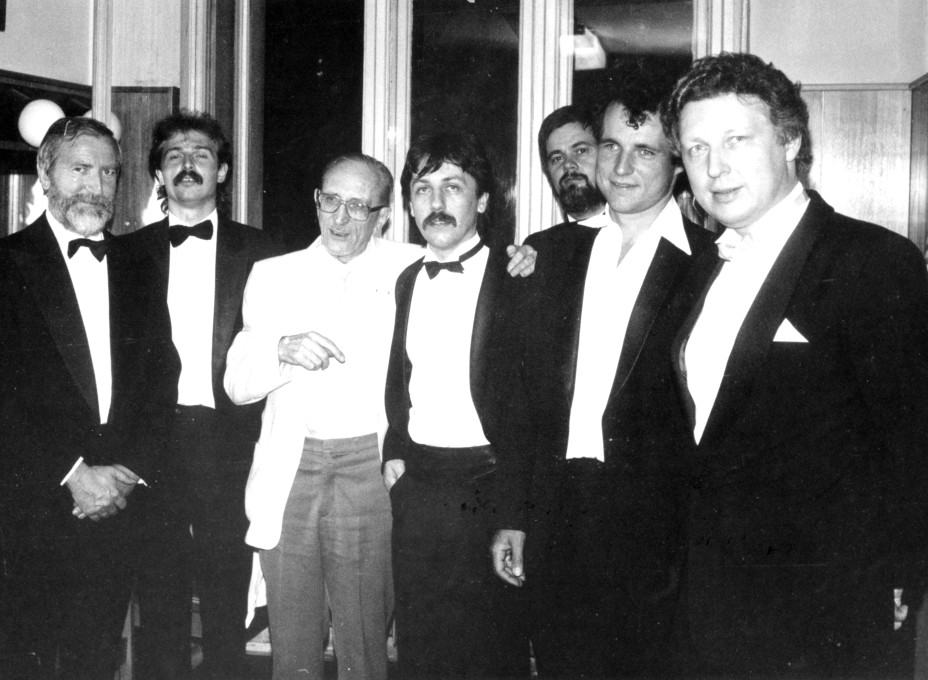
Duarte with the Prague Guitar Quartet, Štĕpán Rak (left) and Vladimir Mikulka (right), Mikulov Festival, Czech Republic, July 1993.
This assistance was repaid in the 1990s with trips to many of the ex-Eastern Bloc countries, especially Bulgaria, Czechoslovakia, Romania and Serbia. A landmark publication was his Melody and Harmony for Guitarists (1980), crystallising all his thoughts on a subject which he had written about for the previous 25 years. After Universal Edition decided to put it out-of-print, Mel Bay Publications seized on the chance and reprinted it in a larger format (and later, as an E-Book), making it a very successful resource for guitarists.
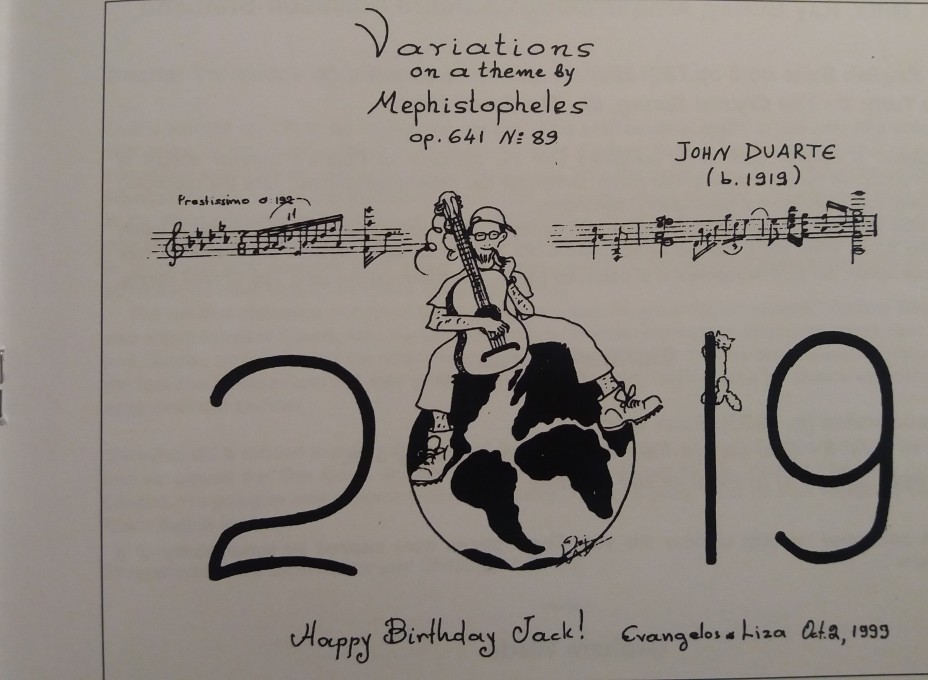
Liza Zoe's cartoon for Duarte's 80th birthday concert in October 1999.
Duarte's 60th, 70th and 80th birthdays inspired celebratory concerts in Wigmore Hall (60th and 70th) and Bolivar Hall (80th), London, as well as in many other countries. At the Convention of the Guitar Foundation of America in October 1999 he received an Award for Lifetime Achievement. In 1996 the writer, Colin Cooper said, "that John Duarte must be the best informed man alive in matters pertaining to the guitar."
During the 1990s and early 2000s Duarte's life continued on this course, with the addition of many recordings of his works. At the time of writing (January 2023) there have been, for instance, 34 recordings of his English Suite Op.31, 16 recordings of Variations on a Catalan Folk Song Op.25, 10 recordings of Idylle pour Ida Op.93, 11 recordings of Sua Cosa Op.52 and there are countless other performances on YouTube, Spotify and other streaming platforms. Three of his compositions have featured on GRAMMY Award-winning albums: two by Sharon Isbin and one by Berta Rojas. Overseas trips included masterclasses and jury duties in Chile, Brazil, Argentina, Japan, Malaysia, Russia, USA and many parts of Europe. He persevered with his uncompromising views, but always with the desire for the classic guitar to be seen as equal to any other instrument, not the quiet salon instrument of some people's imaginations.
In 2001 Duarte made a six-centre visit to the USA and in 2002 visited seven countries, including Russia and Mexico. Having enjoyed good health for most of his life, despite being a lifelong smoker, it was clear by the end of 2003 that he wasn't well. 2004 saw only two overseas trips, early in the year, before he spent four months in hospital. He died on 23 December 2004, leaving a huge hole in the world of the guitar and his family. His obituary appeared in 'The Times', 'Guardian' and 'Independent' as well as in the 'Brief Lives' programme on BBC Radio 4. When Julian Bream died in August 2020, many people were surprised to see Duarte's name on the byline of the Guardian's obituary, written 20 years before.
From his teenage years, Duarte enjoyed off-beat humour. His life-long love of 'The Goon Show' (Spike Milligan, Harry Secombe and Peter Sellers) inspired his later word-plays and the, sometimes, rather groan-inducing titles of some of his compositions and arrangements. Duarte enjoyed socialising, stories, jokes and the advent of e-mail greatly enhanced the exchange of all sorts of information. His later compositions were typeset using an early version of the music software, 'Sibelius', although he never quite mastered some of its intricacies!
Family:
John McLagan, father (d.1919)
Alice Belfort Duarte, mother (1890-1968)
Dorothy Duarte, wife (1921-2006)
Ivor, son (b.1951)
Sylvia, daughter (b.1957)
Christopher, son (b.1960)
